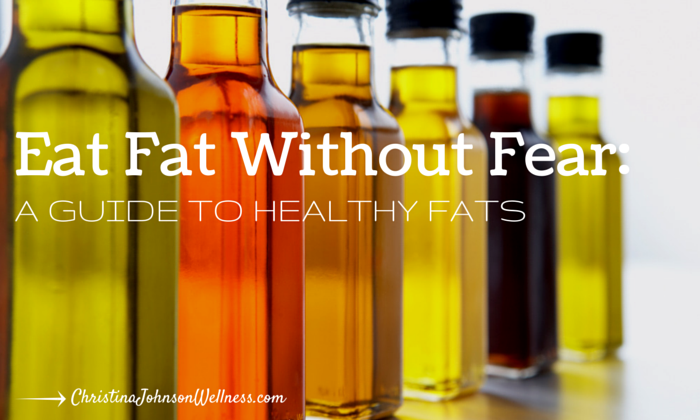Since I have already established that eating fat is critical to our health, the next step we must take is to determine which fats are the best ones to consume. Remember, not all fats are created equal!
So in this post, I will provide a detailed guide to healthy fats. I will describe each of the different types of fats, tell you which ones are the best to use, and which ones are the best to avoid. I have also created a one page chart summarizing this information that you can sign up for at the end of this post.
Types of Fatty Acids
All fats are comprised of fatty acids: saturated fatty acids and unsaturated fatty acids. In order to remain healthy, our body needs both types. Here is a brief description of each of the types of fatty acids.
Saturated Fatty Acids:
Saturated fatty acids are highly stable due to their chemical structure, so they don’t usually go rancid from exposure to heat, light, or air. This makes saturated fats an excellent choice for cooking.
- Examples of saturated fats include animal fats such as beef, lamb, poultry, butter, and ghee. Also included are tropical oils such as coconut oil and palm oil.
Monounsaturated Fatty Acids:
These fatty acids are also relatively stable, but some caution should be exercised when using these types of fats. For example, they should only be cooked with at low temperatures, and they should be stored in dark bottles so that they are not exposed to light.
- Examples of monounsaturated fats include olive oil, almonds, pecans, and avocados.
Polyunsaturated Fatty Acids:
These fatty acids are highly reactive and will go rancid easily if exposed to things such as heat, light, and air. When these fats go rancid, they become damaging to our health. According to Sally Falon and Mary Enig, PhD:
Excess consumption of polyunsaturated oils has been shown to contribute to a large number of disease conditions including increased cancer and heart disease; immune system dysfunction; damage to the liver, reproductive organs and lungs; digestive disorders; depressed learning ability; impaired growth; and weight gain. [1]
Another problem with polyunsaturated fatty acids is that most come in the form of vegetable oils, which have high amounts of omega-6 linoleic acid and very little omega-3 linolenic acid. Ideally, our bodies need the amounts of omega-3s and omega-6s to be approximately equal to each other; however, most Americans consume a much greater amount of omega-6s. Current research estimates that the ratio of omega-6 to omega-3 in the US diet ranges anywhere from 10:1 to 20:1.
Without the correct balance of omega-3 and omega-6 fatty acids, the risk of several health complications increases, such as noninsulin-dependent diabetes, obesity, chronic inflammation, and heart transplant complications.
- Examples of polyunsaturated oils include safflower, corn, sunflower, soybean, cottonseed, and canola oils.
The Best Fats to Cook With
Because saturated fat is the most stable fat, it should be the go-to fat to cook with. It will hold up well under heat, and it is not damaged by light or air.
The fats I most recommend cooking with are:
- Ghee
- Coconut Oil
- Butter
- Tallow
- Duck Fat (I haven’t been brave enough to try this one out yet…but it’s sitting in my fridge just waiting to be used!)
But wait…aren’t saturated fats supposed to be bad for us? The science supporting that conclusion has been shown to be faulty. Although this is a topic for a whole other blog post, I will say that much research has been done supporting the benefits of saturated fats and proving that processed liquid vegetable oils (the polyunsaturated fats) are the real culprit when it comes to heart disease, cancer, obesity, and diabetes.
Tim Boyd sums up much of the research regarding saturated fats with the following statement:
Saturated fats play many important roles in the body chemistry. They strengthen the immune system and are involved in inter-cellular communication, which means they protect us against cancer. They help the receptors on our cell membranes work properly, including receptors for insulin, thereby protecting us against diabetes. The lungs cannot function without saturated fats, which is why children given butter and full-fat milk have much less asthma than children given reduced-fat milk and margarine. Saturated fats are also involved in kidney function and hormone production.
Saturated fats are required for the nervous system to function properly, and over half the fat in the brain is saturated. Saturated fats also help suppress inflammation. Finally, saturated animal fats carry the vital fat-soluble vitamins A, D and K2, which we need in large amounts to be healthy. [2]
Can I Use Any Other Fats?
Monounsaturated fats are great to use as well because the body requires these fats just as they require saturated fats. Just try to avoid using these oils for cooking. They work well in salad dressings, or to use to finish off a meal after it is done cooking. Olive oil may be used to cook with on low heat to medium-low heat, but is not the preferred fat for cooking.
It is worth mentioning that some monounsaturated fats, like nuts and almonds, can be high in omega-6s, so be aware of that.
Fats that work well for cold uses:
- Olive oil
- Flax oil (in small amounts)
- Sesame oil
- Avocado
- Nuts and seeds
Fats to Avoid
Polyunsaturated fats in the form of processed vegetable oils contain such a high amount of omega-6s and are so likely to be damaged in processing that they are best avoided at all costs.
Best fats to avoid:
- Industrially processed liquid oils such as corn, soybean, safflower, cottonseed, canola, vegetable, and sunflower oils
- Anything hydrogenated or partially hydrogenated
- Any fat or oil heated to a very high temperature either in processing or frying
- Margarine
- Any type of “butter spread” such as I Can’t Believe It’s Not Butter, Earth Balance Buttery Spread, or Smart Balance Buttery Spread
So I’m curious to find out…Will this information change which fats you are using in the kitchen? What change would you like to make first?
Sources:
[1] Falon, Sally & Enig, Mary. (2000, January 1). The Skinny On Fats [Blog post]. Retrieved from http://www.westonaprice.org/health-topics/the-skinny-on-fats/#poly
[2] Boyd, Tim. (2000, January 1). Principles of Healthy Diets [Blog post]. Retrieved from http://www.westonaprice.org/health-topics/abcs-of-nutrition/principles-of-healthy-diets-2/



